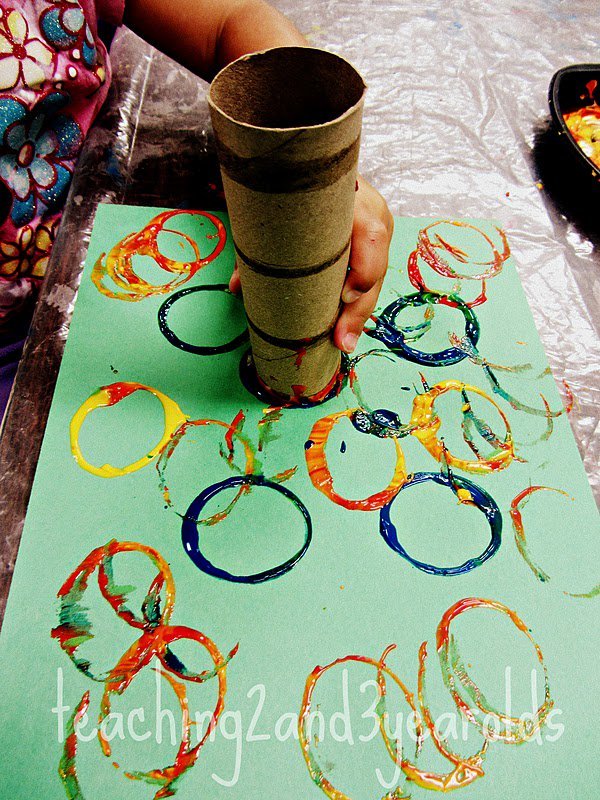Hello Families! There are four basic shapes your toddler child should be able to identify: circle, square, triangle and rectangle. Today we will sing some songs about the circle and then do some painting with circles.
What is our theme? Shapes
What is the lesson (overall purpose)?
To begin to identify the circle shape
MA Guidelines/Standards:
LC48 The younger toddler makes purposeful marks on paper
CD46 The younger toddler repeats actions watching for results
CD47 The older toddler expects certain things to happen as a result of his actions
CD48 The older toddler demonstrates an awareness of the effects of certain actions
CD56 The younger toddler demonstrates an awareness of simple patterns
CD59 The older toddler recognizes and creates simple patterns
CD60 The younger toddler experiments with various wet and dry materials to discover their properties
Learning Outcomes:
Explain to your child that circles are round and have no sides. Show your child images of a lollipop and a snowman.
Songs, Books & Videos (Motivational Techniques)
https://youtu.be/OEbRDtCAFdU Song: Shape song for Kids
https://youtu.be/LlXnXf6FSq8 Song: Circle Song
Materials:
empty toilet paper tube
paper
paint
paper plate(s) to hold paint
Activity (Procedure):
Show your child the circle shape that can be found on the end of the tube. Review the circle song found above.
Get your work area ready with paper laid on the table and paint color on the paper plate.
Have your child dip the end of the tube in the paint and gently stamp it onto the paper to make a circle shape.
Continue until your child is satisfied with their painting.
Activity Wrap Up:
Did you use more than one color to make circles? Are you able to count the number of circles you made?
How do I know what my child is learning? (Assessment)
Learning shapes not only helps children identify and organize visual information, it helps them learn skills in other curriculum areas including reading, math, and science. Learning shapes also helps children understand other signs and symbols.
A child who is able to distinguish between shapes is better equipped to notice the differences in shapes of letters. This helps not only with reading but also with writing. Kids who have practice with different types of shapes and lines can translate those into writing
How can you extend this activity? (Modifications):
Try dipping your finger into the paint and making a circle on a separate piece of paper. (Remember that a circle is a line that goes around and around!)
Helpful Hints: (Pitfalls & Solutions):
An empty paper towel tube will work if you don’t have a toilet paper tube. You may need to cut the paper towel tube in half to make it easier for your child to manipulate.
What is our theme? Shapes
What is the lesson (overall purpose)?
To begin to identify the circle shape
MA Guidelines/Standards:
LC48 The younger toddler makes purposeful marks on paper
CD46 The younger toddler repeats actions watching for results
CD47 The older toddler expects certain things to happen as a result of his actions
CD48 The older toddler demonstrates an awareness of the effects of certain actions
CD56 The younger toddler demonstrates an awareness of simple patterns
CD59 The older toddler recognizes and creates simple patterns
CD60 The younger toddler experiments with various wet and dry materials to discover their properties
Learning Outcomes:
Explain to your child that circles are round and have no sides. Show your child images of a lollipop and a snowman.
Songs, Books & Videos (Motivational Techniques)
https://youtu.be/OEbRDtCAFdU Song: Shape song for Kids
https://youtu.be/LlXnXf6FSq8 Song: Circle Song
Materials:
empty toilet paper tube
paper
paint
paper plate(s) to hold paint
Activity (Procedure):
Show your child the circle shape that can be found on the end of the tube. Review the circle song found above.
Get your work area ready with paper laid on the table and paint color on the paper plate.
Have your child dip the end of the tube in the paint and gently stamp it onto the paper to make a circle shape.
Continue until your child is satisfied with their painting.
Activity Wrap Up:
Did you use more than one color to make circles? Are you able to count the number of circles you made?
How do I know what my child is learning? (Assessment)
Learning shapes not only helps children identify and organize visual information, it helps them learn skills in other curriculum areas including reading, math, and science. Learning shapes also helps children understand other signs and symbols.
A child who is able to distinguish between shapes is better equipped to notice the differences in shapes of letters. This helps not only with reading but also with writing. Kids who have practice with different types of shapes and lines can translate those into writing
How can you extend this activity? (Modifications):
Try dipping your finger into the paint and making a circle on a separate piece of paper. (Remember that a circle is a line that goes around and around!)
Helpful Hints: (Pitfalls & Solutions):
An empty paper towel tube will work if you don’t have a toilet paper tube. You may need to cut the paper towel tube in half to make it easier for your child to manipulate.

 RSS Feed
RSS Feed
